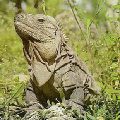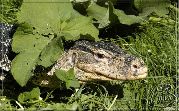
Iguana ringtail
Ring-tailed iguanas in scientific circles bear the generic name Cyclura, in fact, which is a Latin translation of the word “ring-tailed” adapted to our speech. It is formed from the ancient Greek words Cyclos (κύκλος) – “circular” and Oura (οὐρά) – tail, and describes the individual feature of these lizards – the presence of a tail, the scales on which are folded into a ringed pattern. Among exotic lovers, the ring-tailed iguana is also known as the rhinoceros iguana due to its fantastic appearance. On its large head there are various folds, shields and large cone-shaped scales, resembling horns and giving the reptile a particularly bizarre appearance. Among the subspecies of ring-tailed iguanas, there is even a specific subspecies of the rhinoceros iguana, Cyclura cornuta. The similarity of this lizard with this odd-toed ungulate is manifested in the presence of pronounced three-horned scales on its muzzle. All ring-tailed iguanas are rock dwellers in the Caribbean. In terms of nutrition, they have some similarities with the Galapagos lizards, as they also prefer cacti, but in general their diet is more varied.
Contents
Classification
Kingdom: Animals
Type: Chord
Class: Reptiles
Order: Scaly
Suborder: Lizards
Family: Iguana
Genus: Cyclurs Cyclura or ring-tailed iguanas
Species: Ribbed cyclura (Cyclura carinata), Jamaican cyclura (Cyclura collei), Rhino cyclura (Cyclura cornuta), Common cyclura (Cyclura cychlura), Blue cyclura (Cyclura lewisi), Cuban cyclura (Cyclura nubila), Virginia cyclura (Cyclura pinguis) ), Cyclura Ricordi (Cyclura ricordi), Bahamian cyclura (Cyclura rileyi)
Appearance
All reptiles representing one genus usually have some characteristic that is typical for many individuals. In ring-tailed iguanas, this is the structure of the teeth, which are not particularly suitable for biting, because they do not have serrations on the cutting edge. Ring-tailed iguanas are also distinguished from true iguanas by a small spinal crest, which almost disappears in the area of the shoulders and sacrum, and a noticeably less developed throat sac. In addition to the rings on the tail, these lizards, namely, on the upper side of each 3-4 rows of transverse scales, have sharp horn outgrowths directed to the sides.
The coloration of ring-tailed iguanas is generally uniform brown or greenish, sometimes a pattern of darker transverse olive stripes stands out on the body. The size of these lizards is about 1 meter. They have a large massive body, smoothly turning into a tail, and powerful limbs.
In appearance, the cycluras are a rather diverse community. The most interesting in terms of appearance is the aforementioned species of rhinoceros iguana Cyclura cornuta. The largest species of ring-tailed iguanas is Cyclura carinata, which grows up to 1 meters and is also known as the keeled or ribbed cyclura. Another pronounced feature of it is an unpleasant odor, apparently due to the feeding of this iguana with guinea fowl grass growing in Jamaica, where the lizard lives. So even scavengers avoid the carcasses of these reptiles. Another Jamaican ring-tailed iguana, Cyclura collei, has an interesting pattern of dark inverted triangles located on the sides under the spinal crest. Northern Bahamian Cyclura (Cyclura cychlura) is a typical representative of the genus, in its color it has orange shades. The blue ring-tailed iguana is considered the rarest, and perhaps even extinct, species. In the appearance of Cuban cycluras, a large yellowish ridge crest stands out. And the brightest among the ring-tailed iguanas can be called the Bahamian cyclura. In its color, dark brown color is combined with yellow-orange spots throughout the body. And finally, another degenerate iguana, Rikorda’s cyclura, is a grey-green lizard very similar to the ribbed iguana.
Distribution and habitation
The habitat of ring-tailed iguanas, as already mentioned, is limited to the islands of the Caribbean, in particular, the Antilles, Bahamas, British and other archipelagos of the Caribbean. The biotopes of the places of settlement of cycluras are different. Some ring-tailed iguanas are predominantly terrestrial, while others prefer to live in trees. But, in any case, shelters are vital for these lizards, and it does not matter if it is a hole in the ground or a hollow in a tree trunk. Often ring-tailed iguanas live on rocky coasts, choosing their shelter in cracks between stones.
The islands of the Caribbean are not of volcanic origin. Their main component is highly eroded limestone, so there are many natural caves in these areas that are suitable for hiding ring-tailed iguanas. Some types of ring-tailed reptiles choose ready-made natural caves, while others dig their own holes in sandy soil. The habitats of lizards are almost never deserted, although they are characterized by an arid climate. However, in the habitat of ring-tailed iguanas, there is always some kind of xerophytic vegetation, such as dry acacia or cacti.
And of course, each species of ring-tailed iguana lives in its own territory, rarely crossing with other species. Namely: a rhinoceros iguana on the island of St. Domingo; ribbed cyclura – in the Turks and Caicos; the Cuban iguana, respectively, in Cuba; common cyclura is found in the Bahamas; blue cyclura – a resident of the Grand Cayman Island; the Bahamian ring-tailed iguana is found on San Salvador and nearby small islands; the virgin cyclura today can only be found on the island of Anegada, and earlier it was widely settled in Puerto Rico; Cyclura Ricord lives in Haiti and in the Dominican Republic.
Behavior and lifestyle
 Ring-tailed iguanas are amazing creatures. In their behavior, territoriality is combined with mutual assistance. For example, they each prefer to live in a separate territory, however, the territory of the male can intersect with the territories of the females. And the male of the cyclura is dominant. However, during the molting period, ring-tailed iguanas take advantage of each other’s opportunities. Relatives surround the molting individual and help her to tear off dead skin pieces, which are then eaten. Moreover, the molting cyclura herself gladly exposes other lizards to other lizards that have not yet been “processed” parts of the body. This feature is scientifically called intraspecific courtship or “grooming”.
Ring-tailed iguanas are amazing creatures. In their behavior, territoriality is combined with mutual assistance. For example, they each prefer to live in a separate territory, however, the territory of the male can intersect with the territories of the females. And the male of the cyclura is dominant. However, during the molting period, ring-tailed iguanas take advantage of each other’s opportunities. Relatives surround the molting individual and help her to tear off dead skin pieces, which are then eaten. Moreover, the molting cyclura herself gladly exposes other lizards to other lizards that have not yet been “processed” parts of the body. This feature is scientifically called intraspecific courtship or “grooming”.
Mostly terrestrial creatures, ring-tailed lizards are excellent tree climbers. People happened to find cyclurus at a height of 5 meters from the ground. In their habitats, they are slowly replacing reptiles from the genus of true iguanas, but at the same time they remain quite rare and protected species. By nature, ring-tailed iguanas are very shy and cautious. They don’t trust people. It is enough to scare the cyclura once, and she will avoid your company for a long time. However, with patience, you can just as well tame an iguana, and he will gradually learn to trust you.
Some types of cyclura swim well, and, despite the rather meek nature, they are able to actively defend themselves in case of danger. Their main weapon is a spiked strong tail. In moments of danger, the ring-tailed iguana opens its mouth wide and deftly beats with its tail, inflicting sensitive, and even traumatic blows to the enemy. But ring-tailed iguanas defend themselves in extreme cases, preferring to flee. The eyesight of lizards is not very good, so they are active mainly during the day. And if everything is calm around, then the ring-tailed iguanas get out of their hiding places and bask in the sun with pleasure.
In captivity, these reptiles live long enough, the longest life span of a lizard – 30 years – was recorded in one of the American zoos. In general, when keeping ring-tailed iguanas, experts advise to be guided by their natural behavior. In particular, males should not be kept together, as these dominant individuals will always sort things out. Joint maintenance of females is possible, but also with caution, since they have their own hierarchy. It happened that females, becoming outcasts in the society of cycluras, were seriously abused by their neighbors and even injured.
Food
 Ring-tailed iguanas are vegetarians. Their diet includes a variety of vegetation – cacti, leaves, flowers, fruits and berries. In this area, scientists have noticed an interesting feature of lizards: the seeds that pass through their digestive tract germinate faster afterwards, so that ring-tailed iguanas often become seed dispersers, for example, when migrating females during breeding. From animal food, the diet of lizards is supplemented by insect larvae, crab fry, various worms and slugs living on plants, sometimes carrion, mushrooms, fish and small animals or even relatives. They drink water in very small quantities, so in captivity it is enough to fill the drinker with water every other day. Here is a sample menu recommended by terrariumists for ring-tailed iguanas:
Ring-tailed iguanas are vegetarians. Their diet includes a variety of vegetation – cacti, leaves, flowers, fruits and berries. In this area, scientists have noticed an interesting feature of lizards: the seeds that pass through their digestive tract germinate faster afterwards, so that ring-tailed iguanas often become seed dispersers, for example, when migrating females during breeding. From animal food, the diet of lizards is supplemented by insect larvae, crab fry, various worms and slugs living on plants, sometimes carrion, mushrooms, fish and small animals or even relatives. They drink water in very small quantities, so in captivity it is enough to fill the drinker with water every other day. Here is a sample menu recommended by terrariumists for ring-tailed iguanas:
green vegetable food: cabbage, mustard leaves, turnip, dandelion, parsley.
Legumes: sprouted beans, soybeans, alfalfa.
Vegetable mixes: grated zucchini, corn, broccoli, cauliflower and Brussels sprouts, asparagus, yams.
Juicy fruit foods: melons, apples, plums, pears, bananas, grapes
Dry dog food can sometimes be given, but it’s best to consult a specialist about specific varieties. And of course, vitamin and mineral supplements for reptiles are necessary.
As for the general characteristics of the diet of ring-tailed iguanas, it should contain at least 70% vegetable food, no more than 10% vegetable and fruit food, and only 5% animal food. Young animals should grind their food. And you should not offer different foods to the iguana all the time, it is better to diversify the diet for weeks, not immediately, but gradually replacing products in it.
Reproduction
 Ring-tailed iguanas are characterized by sexual dimorphism. Male lizards are larger, they have more spinal ridges, and there are special pores on the thighs, from which pheromones are released during the breeding season. Puberty in ring-tailed iguanas occurs after a sufficiently long time – from 3 to 7 years. But females mature faster – in 2-5 years. The mating season for lizards begins every year at the same time – in the spring, from May to June, before the onset of the rainy season. And females lay eggs about a month after mating. At the same time, female individuals of ring-tailed iguanas, who are not inclined to roam the rest of the time, go in search of a nesting place before laying eggs, so that they can go far from their shelters. They dig the nest themselves or choose a suitable shelter. Its main characteristics are depth and width, so that the female can fit entirely there and easily turn around if necessary.
Ring-tailed iguanas are characterized by sexual dimorphism. Male lizards are larger, they have more spinal ridges, and there are special pores on the thighs, from which pheromones are released during the breeding season. Puberty in ring-tailed iguanas occurs after a sufficiently long time – from 3 to 7 years. But females mature faster – in 2-5 years. The mating season for lizards begins every year at the same time – in the spring, from May to June, before the onset of the rainy season. And females lay eggs about a month after mating. At the same time, female individuals of ring-tailed iguanas, who are not inclined to roam the rest of the time, go in search of a nesting place before laying eggs, so that they can go far from their shelters. They dig the nest themselves or choose a suitable shelter. Its main characteristics are depth and width, so that the female can fit entirely there and easily turn around if necessary.
The average number of eggs laid by a ring-tailed iguana is 2-6. Moreover, the eggs of this lizard are considered the largest among all egg-laying reptiles. The clutch may be larger, it all depends on the age and size of the female. When the clutch is ready, the ring-tailed iguana does not leave the nest, but continues to carefully protect it from any encroachment. The most interesting thing is that the temperature inside the shelter remains constant, equal to about 30 degrees. The offspring appears in 2-3 months, and small ringtails can get out to the surface from a deep nest for a long time. They become independent almost immediately, but the mortality rate of young ring-tailed iguanas is generally very high and reaches 100% in some regions. This is due to the many predators and human economic activity, which reduces favorable areas for lizards to live.
Sources of
http://ru.wikipedia.org
http://www.apus.ru
http://www.megabook.ru
http://forum.zoologist.ru/
http://en.wikipedia.org
http://www.herpnut.com/





